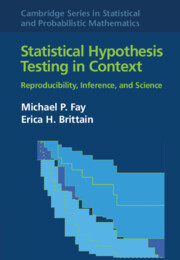Refine search
Actions for selected content:
2703 results in General statistics and probability
3 - Risk Measures
-
- Book:
- Quantitative Enterprise Risk Management
- Published online:
- 28 July 2022
- Print publication:
- 05 May 2022, pp 71-105
-
- Chapter
- Export citation
6 - Copulas
-
- Book:
- Quantitative Enterprise Risk Management
- Published online:
- 28 July 2022
- Print publication:
- 05 May 2022, pp 163-201
-
- Chapter
- Export citation
7 - Stress Testing
-
- Book:
- Quantitative Enterprise Risk Management
- Published online:
- 28 July 2022
- Print publication:
- 05 May 2022, pp 202-226
-
- Chapter
- Export citation
Appendix - Probability and Statistics Review
-
- Book:
- Quantitative Enterprise Risk Management
- Published online:
- 28 July 2022
- Print publication:
- 05 May 2022, pp 622-649
-
- Chapter
- Export citation
1 - Introduction to Enterprise Risk Management
-
- Book:
- Quantitative Enterprise Risk Management
- Published online:
- 28 July 2022
- Print publication:
- 05 May 2022, pp 1-38
-
- Chapter
- Export citation
15 - Risk Mitigation Using Options and Derivatives
-
- Book:
- Quantitative Enterprise Risk Management
- Published online:
- 28 July 2022
- Print publication:
- 05 May 2022, pp 421-441
-
- Chapter
- Export citation
5 - Extreme Value Theory
-
- Book:
- Quantitative Enterprise Risk Management
- Published online:
- 28 July 2022
- Print publication:
- 05 May 2022, pp 132-162
-
- Chapter
- Export citation
3 - From Scientific Theory to Statistical Hypothesis Test
-
- Book:
- Statistical Hypothesis Testing in Context
- Published online:
- 17 April 2022
- Print publication:
- 05 May 2022, pp 23-48
-
- Chapter
- Export citation
10 - Economic Scenario Generators
-
- Book:
- Quantitative Enterprise Risk Management
- Published online:
- 28 July 2022
- Print publication:
- 05 May 2022, pp 291-306
-
- Chapter
- Export citation
18 - Risk-Adjusted Measures of Profit and Capital Allocation
-
- Book:
- Quantitative Enterprise Risk Management
- Published online:
- 28 July 2022
- Print publication:
- 05 May 2022, pp 511-555
-
- Chapter
- Export citation
20 - Crisis Management
-
- Book:
- Quantitative Enterprise Risk Management
- Published online:
- 28 July 2022
- Print publication:
- 05 May 2022, pp 594-621
-
- Chapter
- Export citation
9 - Two-Sample Studies with Ordinal or Numeric Responses
-
- Book:
- Statistical Hypothesis Testing in Context
- Published online:
- 17 April 2022
- Print publication:
- 05 May 2022, pp 129-160
-
- Chapter
- Export citation
References
-
- Book:
- Statistical Hypothesis Testing in Context
- Published online:
- 17 April 2022
- Print publication:
- 05 May 2022, pp 404-419
-
- Chapter
- Export citation
8 - Assumptions and Hypothesis Tests
-
- Book:
- Statistical Hypothesis Testing in Context
- Published online:
- 17 April 2022
- Print publication:
- 05 May 2022, pp 124-128
-
- Chapter
- Export citation
15 - Causality
-
- Book:
- Statistical Hypothesis Testing in Context
- Published online:
- 17 April 2022
- Print publication:
- 05 May 2022, pp 277-301
-
- Chapter
- Export citation
4 - One-Sample Studies with Binary Responses
-
- Book:
- Statistical Hypothesis Testing in Context
- Published online:
- 17 April 2022
- Print publication:
- 05 May 2022, pp 49-66
-
- Chapter
- Export citation
Frontmatter
-
- Book:
- Quantitative Enterprise Risk Management
- Published online:
- 28 July 2022
- Print publication:
- 05 May 2022, pp i-iv
-
- Chapter
- Export citation
Contents
-
- Book:
- Quantitative Enterprise Risk Management
- Published online:
- 28 July 2022
- Print publication:
- 05 May 2022, pp vii-xiv
-
- Chapter
- Export citation
8 - Market Risk Models
-
- Book:
- Quantitative Enterprise Risk Management
- Published online:
- 28 July 2022
- Print publication:
- 05 May 2022, pp 227-261
-
- Chapter
- Export citation

Statistical Hypothesis Testing in Context
- Reproducibility, Inference, and Science
-
- Published online:
- 17 April 2022
- Print publication:
- 05 May 2022
